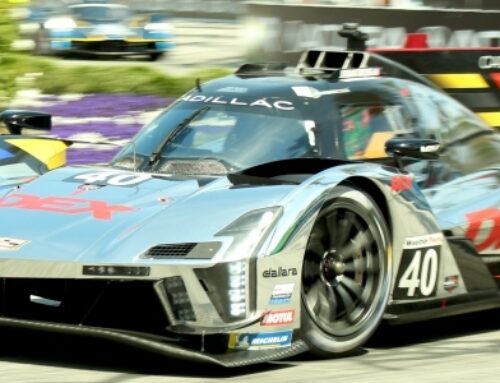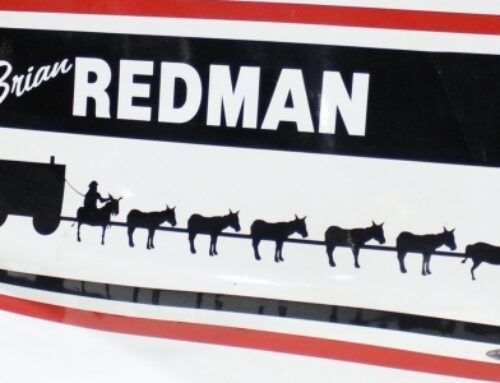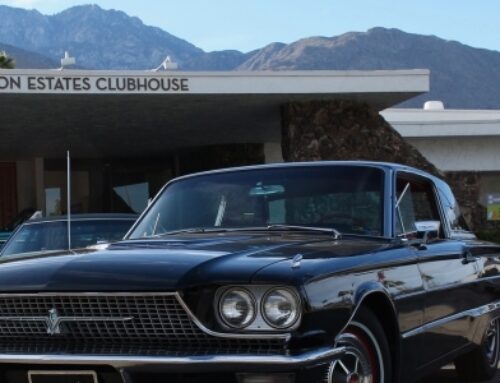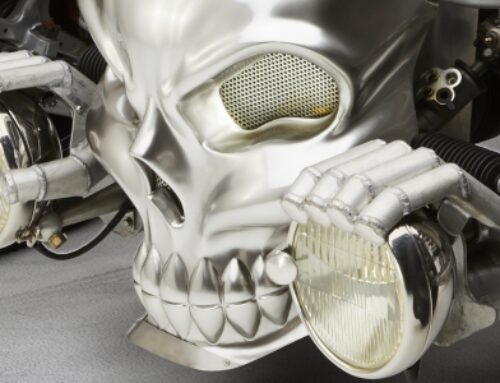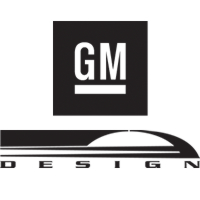Is going vintage an oddity or a way of life? The answer is – it depends, unless it’s at Modernism Week. The thought of a scooter or car of the 1950s, 60s, and 70s can elicit all sorts of imagery, often fostered by both the Hollywood film and music industry. Brands like Lambretta, Piaggio, Vespa, Avanti, Pontiac, Oldsmobile, and Studebaker are forever tied to a long-gone era. Do the products from the last century fit comfortably in today’s world or are these anomalies better suited to museum exhibits or maybe in the darkest recesses of our gray matter?
Article and images © John Grafman
Of course, the answer is very subjective. Those that grew up with these will have a fondness recalling adventures and independence on a raspy, motorized scooter and being unshackled from the parents. No doubt, teenagers that were around for the first wave of the British Invasion were also able to forge friendships with their first cars, just as the Rolling Stones were gathering momentum in HiFi. Becoming an explorer didn’t require a spaceship, instead a tankful of gasoline was all it took. The robust economy of the time created boundless leisure opportunities and the growth of the recreational vehicles. This opened the door to a new world of imagination and faraway destinations to conquer. Locked in that dance down memory lane is a style that is conforms to both the technology and tastes that are commonly referred to as Mid-Century.
Certainly, some designs have aged better than others, as one would expect from any era. Frequently, the forms are functional, simplistic, and yet expressive. Scooters do tend to be similar, as the packaging is both comparable and minimalistic. And that’s where the details come in. From badging to seating, it’s the little things that matter, as so much else is forced by the functional nature of the beast.
Kick-Starting The Vintage Scooter Shine & Show
The Shine & Show – Lambretta & Vespa Vintage Scooter Show, a newcomer to Modernism Week, reflects a romance of sort with these two-wheeled conveyances gracefully positioned around a pool at the Sonoran Event Center in Palm Springs. “Both the average Joe and enthusiast will appreciate the sophisticated, timeless, retro appeal of the classic scooter,” according to Marvyn Mack of Soulside Productions, the Event Coordinator. Mack dives a little deeper, stating, “A Keen eye will spot a few models that will stand apart from the typical plastic, commuter scooter. A retro Vespa or Lambretta is known to make people do a double take when it’s spotted. It sometimes makes people’s hearts skip a beat being overwhelmed with joy or a feeling of pure shock value while observing a sexy piece of retro art on two-wheels.”
The forms that wrap the mechanicals could be seen as animalistic or perhaps feminine in shape. But the embellishment is like hot-rodding on a small scale. Because scooters are small and less complicated that a car, this opens the door to ease of personalization. While it’s fine to leave a Vespa unmolested, it’s not unheard of to leave one’s imprint on the shape. Nothing beats the in-person experience to fully appreciate handiwork. However, movies can capture the magic for all eternity. Quadrophenia is film based on The Who album of the same name. The title comes from the character’s multiple personalities, but in an unintentional way, this could reflect the various scooters seen on the silver screen that range from completely stock to crazy outrageous.
Mack does mention, “The most desirable and valuable among these scooters are the following – the SX200, TV175, and TV200 models. Surprisingly, these scooters in stock form range, depending on the condition, anywhere from $7500 – $20,000 USD.” The obvious question for many boils down to, can one resist the temptation to improve upon perfection?
The Vintage Car Show staged at the Palm Springs Convention Center during Modernism Week does embrace mid-century with a passion. The broad selection is a smorgasbord of style, where attendees can take-it or leave-it. The flowing forms of a Jaguar E-Type are juxtaposed against the hard-edge, first-generation Camaro. The automotive paint colors of the time are also indicative of the mission of each car. The Jag is subdued while the Chevy is acid-trip bright. The backdrop of the mid-century influenced architecture of the convention center coupled with go-go dancers and period music accentuate the sensibilities from when these cars were produced.
A Mix of Mid-Century Cars, Music, and Go-Go Dancers
Jeff Stork is the co-curator for this brilliant event, and he maintains one of the larger collections of mid-century period cars in the area. Coming out of a conservative and regimented era, people viewed transportation differently. What happened? Jeff reminds us, “The role of the car in allowing the owner to express his personality – you were what you drove, and so people chose cars carefully to make a personal statement. This show celebrates the attitude of the early sixties, which I would describe as a youthquake. Cars were tailored to youthful attitudes, with sporty styling, bucket seats and bright colors. Imported sports cars were popular on the coasts and influenced the domestic market, so that small and sporty American cars became the hottest industry trend.”
Coupling style and music from the mid-century is an artform. Handling the music at the Vintage Car Show is Kellee McQuinn, aka DJ ModGirl, as she’s well versed in weaving the two together in a seamless manner. From her vantage point, DJ ModGirl states what makes this event special is, “The meticulous curation of elegant automobiles and musical anthems of that era. When making my Car Show playlist, I correlated the musical genre to the year of the car I was looking at and asked myself ‘what would the cool kids of this time period be listening to as they were driving down the road.’ One of the magical things about Palm Springs, and Modernism Week in particular, is that we jump in a proverbial time machine and relive the bygone area where style, sophistication and swankiness reigned. To have the backdrop of all these classic cars amidst people dressed in vintage clothes… it’s just such a special experience.”
The right music is a dialogue linking our memories to the current stable of cars on display. A few of those songs that tap into the way-back machine that’s resting between our ears are, as DJ ModGirl notes, “Fun Fun Fun by the Beach Boys, Mustang Sally, and pretty much every Motown hit you can think of. I love playing the soundtrack that fits with these classic cars. It’s so much fun to watch everybody be-bopping and smiling and singing along while taking in the breathtaking designs. It’s like transporting to another time.”
DJ ModGirl finds the qualities that make mid-century autos special to are, “The attention to detail, the unique lines, and the overall sexiness of each distinct car. These cars have personalities and evoke a visceral response… at least they do for me. That, and the smell of gasoline….”. Perhaps that’s an aspect that gets overlooked, but the nose knows!
Cars Have Personalities and Evoke a Visceral Response
Guests in period fashions only further add to the flavor. There is not a single car on display that isn’t delightful in its own way. Each has a style that in a way is a signal as to not only what the car is all about, but the owner as well.
Yet, is this representation correct in the sense that not all cars from those mid-century decades are as attractive? Rather than one magnetic design next to another, alternating with more mundane cars from the same period would really showcase the magic of these standouts. How can one understand what sweet is without experiencing bitterness. As space is limited at this event, it’s understandable that those slots go to the winners and fan favorites. From a true historical perspective, it is necessary to take that deep dive into a time where these cars lived, breathed, and roamed the earth, even if it isn’t pretty.
Tom Dolle, graphic designer extraordinaire, also has the honor of co-curating this year’s collection at the Vintage Car Show. This isn’t his first rodeo, and he knows what he likes. Dolle states, “I’m always drawn to color and textiles. The unbelievable assortment of fabric options and available colors that puts our modern cars to shame. There was a time when no one bought grey cars, and interiors of even economy cars had 4-5 color and material choices. There was also a high level of design detail and craftsmanship with solid materials, for cars that were only designed to last a few years. I’m especially drawn to switches, dials, buttons, gauges—and the thought and care that went into designing each and every one. Cars were such an important aspect of mid-century life and reflected the lifestyles of the era—homes were even designed with carports, and restaurants had circular driveways with porte-cocheres to put the car on display! Of course, safety and emissions weren’t an issue then, and cars are much better engineered and built these days, with little need for regular maintenance.”
Vintage cars from the mid-century are cool, but it isn’t all rainbows and puppy dog tails. Tom Dolle pragmatically continues, “Cars from before about 1975 were unique reflections of their times, and we’ll never see anything like them again. I think there will continue to be a fascination for these crazy machines, especially the more rare and unusual ones. But they require a lot of maintenance, and it’s becoming more of a problem finding good mechanics and quality parts. The promise of 3D printing for hard-to-find parts hasn’t really materialized, and young people haven’t shown the same level of interest in cars as older generations. But there are a finite number of classic cars around, and the numbers keep dwindling.”
The Chrome and Fin Era of the 50’s are Well Represented at Modernism Week
The efforts of Mack, Stork, Dolle, and McQuinn and countless others are not lost on those that attend. One such fan of Modernism Week is John Kraman, Lead TV Commentator/Analyst for Mecum Auctions – the world’s largest collector car auction company, dating back to 1988. John is no Johnny-come-lately to this desert extravaganza, and in fact he states, “During the past 17 years on-air, I have weaved in references to pop culture including design, colors, fashion, and music trends right along with the car commentary that interestingly includes a high percentage of cars from this era.
“I first attended Modernism Week in 2010 as a winter escape from my home in Northern Illinois but immediately realized the immersion in both education and design was irresistible moving forward. I have attended every year since. I have learned that a huge bonus to this event are the period correct cars that are a part of the vintage landscape. As expected, the Chrome and Fin era of the 50’s are well represented as well as luxury cars from the 60’s. While the flashy convertible versions of all these classics are the stars, there are plenty of sedans and even station wagons that accurately add authenticity. The vintage car culture is a very important element of the experience and kudos to both the organizers and car clubs that coordinate the displays. And although the architecture, cars and fashion draw us in, it’s the passion and enthusiasm of everyone involved that brings us all back every year.”
Modernism Week in Palm Springs is something that one must experience in person, and as Kraman claims, “It is the ultimate lifestyle event of its type.” Truer words have never been spoken.



















